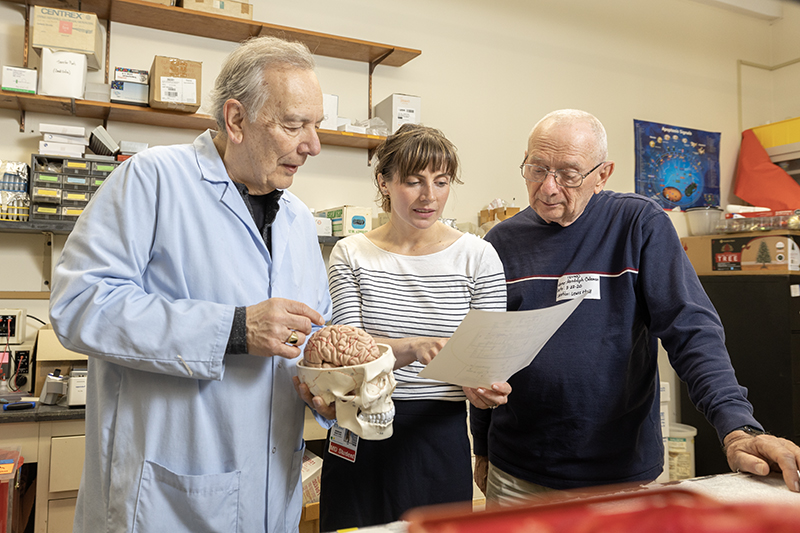Computer model aids biochemist in search for Alzheimer’s treatment

At first glance, a biochemist and a chemist with a strong mathematical bent may seem an unlikely pair to study the origins of Alzheimer’s disease.
But funding agencies seem to like this unusual tag team – and their complementary skills. Last fall, the Alzheimer’s and Related Disease Research Award Fund (ARDRAF) approved a grant to support research undertaken by Frank Castora, PhD, EVMS Professor of Physiological Sciences, and Randolph Coleman, PhD, Professor of Chemistry at the College of William and Mary. It is the second grant the two have obtained from the organization and the fourth overall since the beginning of their collaboration in 2014.
[Pictured are Dr. Castora, left, Dr. Coleman, right, and Morgan Shelton, who worked with the researchers first as a student at W&M and now as an EVMS medical student.]
Dr. Castora has spent much of his career in his EVMS lab studying the inner workings of Alzheimer’s disease. Alzheimer’s affects one in nine Americans age 65 and older and can result from a combination of lifestyle choices as well as a genetic predisposition to the disease.
The research Dr. Castora and Dr. Coleman are undertaking is based on Dr. Castora’s discovery that a mutation in mitochondrial DNA is strongly associated with Alzheimer’s disease. The mutation can interfere with the work of mitochondria, known as the “powerhouse of the cell.”
“The grant reviewers felt that the project was very innovative and would open up further studies by us and others in the field to pursue an understanding of how mitochondria can become dysfunctional and lead to the death of neurons in the brain and, ultimately, Alzheimer’s Disease,” Dr. Castora says.
Their latest study is broadening this approach — looking at changes in gene activity, or “expression,” among the estimated 10,000 genes active in the brain. They believe that some of these genes may also play a role in the death of brain cells in Alzheimer’ disease.
Drs. Castora and Coleman met through service on their respective admissions committee. They began working together soon after learning of their shared interest in neurodegenerative diseases such as Alzheimer’s.
Utilizing his skills in computational biology, Dr. Coleman has spent the last several years building a computer model of Alzheimer’s. The model mimics the molecular structure and chemical interactions inside a brain affected by Alzheimer’s disease. It relies on thousands of bits of research data scoured from the medical literature by a team of students. Each new nugget of information helps tweak the model’s accuracy.
In his lab, Dr. Castora experiments with tissue samples of known Alzheimer’s brains, comparing reactions to control samples – brain tissue proven to be free of Alzheimer’s. When Dr. Castora finds differences in gene expression, he provides his findings to Dr. Coleman.
“[Dr. Castora] supplies me with information that helps me fine tune my model,” Dr. Coleman says. “And in turn I can suggest things back to him that help him decide what to do next. It’s a wonderful give and take.”
The model also serves as an experimental “sandbox,” Dr. Castora says, where the researchers can raise or lower gene expression. Dr. Castora’s lab then provides real-world confirmation of an experiment’s outcome.
As this back-and-forth experimentation continues to educate the computer model, the pair hope to identify a small number of genes that may serve as target for Alzheimer’s treatments.
To continue to fund their work, the researchers hope their innovative approach can win grant funding from the National Institutes of Health – the gold standard in biomedical research.
Dr. Castora believes the lab-model process can be an effective tool to study other diseases.
“I think there’s clearly an application of this approach to not only Alzheimer’s disease,” he says “but other neurodegenerative diseases as well.”